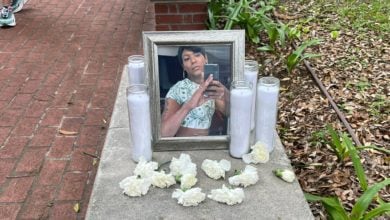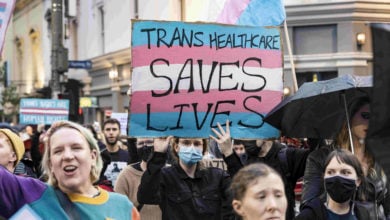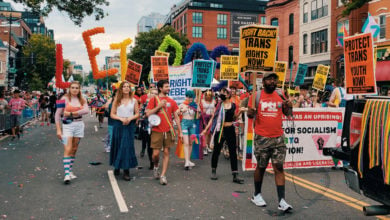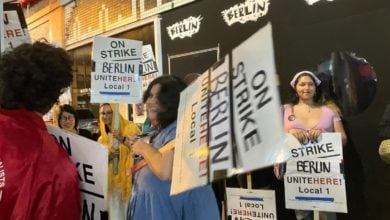Recently we have witnessed striking
advances in the acceptance of the lesbian, gay, bisexual and
transgender community nationwide, especially among young people.
Despite countless bigoted attacks in the media and legislatures, the
movement for LGBT rights has not diminished.
The truest testament to youth
acceptance is a recent Gallup Poll released in May of this year that
showed a dramatic upsurge in approval for same-sex marriage among
18-34 year olds from a 54 percent approval rating in 2010 to 70
percent in 2011, a very significant increase.
These results are no mistake,
especially when one considers the diligent work done by the LGBT
community and its allies. The Gay Straight Alliance, an organization
found in many high schools and colleges, seeks to empower youth to
fight homophobia and transphobia. Begun in 1998 in California with
only 40 clubs, today it has grown to 850 clubs in 31 states. The
work done by the GSA has played a key role in expanding youth
involvement in the fight for equality by creating alliances among
LGBT youth and their peer allies. This work is incredibly brave and
continues to smash oppressive divisions.
That unified work between LGBT youth
and their allies came to fruition this past prom season. We saw in
the states of Virginia, Florida and Maine—all states that ban
same-sex marriage—LGBT teens were nominated and crowned prom kings
and queens. We also saw Belinda Sanchez, an 18-year-old lesbian
student at Proviso East High School in Illinois, fight for and win
the right to wear a tuxedo, saying, “I didn’t just stand up and
fight for myself, I did it for everyone who’s in a position like
I’m in.”
A Long Island Catholic high school
barred same-sex couples from attending prom. St. Anthony’s High
School cited the Church’s views on same-sex marriage as justification
for the ban. Being a private school, St. Anthony’s is not bound by
New York’s anti-discrimination laws.
While the St. Anthony’s incident
highlighted the loopholes that allow for discriminatory acts
perpetrated by private facilities, discrimination is not limited to
private schools. Recently, it has come out that public school
districts throughout Georgia and Tennessee have been blocking access
to LGBT websites. This is especially frustrating when one considers
the high rate of suicide among LGBT teens and the many LGBT-positive
websites that exist to help LGBT youth. For many students, especially
poor and working-class high school students, the only access to the
Internet is at school. There is currently a campaign by the ACLU to
stop the blocking of LGBT sites.
Though increased equality in the public
school system has been a battle, today we can see that great strides
have been made in the creation and defense of LGBT youth rights. For
this generation, it has moved well beyond small-scale recognition and
visibility.
Last year, we found out about the very
first transgender man to play NCAA Division 1 basketball, Kye Allums,
who plays for George Washington University. This is a gigantic step
in a very long march. Allums attends GWU on a scholarship to play for
their women’s basketball team and will keep that status due to
protection by the NCAA stating that “the member schools are advised
to consider the gender classification of student-athletes’ state
identification documents, such as driver’s licenses and voter
registration, to determine appropriate participation.” He is
further protected by Washington, D.C., law, which prohibits
discrimination based on gender identity.
Positive visibility and empowerment
in pop culture
Reaching even further, LGBT youth have
gained greater visibility throughout a number of arenas in
contemporary pop culture.
Over the past year alone, there have
been many songs with lyrics that empower LGBT youth. In the wake of
the suicides of young gay students who were bullied through bigotry
and pushed down a road where suicide seemed to be the only solution,
many artists affected by the tragedies were inspired to empower LGBT
youth through song.
Lady Gaga, who famously wrote “Born
This Way,” has no doubt been the most vocal supporter of LGBT
equality in the music industry. She has not only taken LGBT rights to
the forefront of her music, but in almost every interview and
appearance she makes it a point to confront the struggles faced by
LGBT youth and the community at large. Whether it is through her
music or discussing bullying in interviews, Lady Gaga is using her
position as a pop icon to truly speak to the populace.
Outside of the music industry, TV
series such as ‘Glee’ have brought lesbian and gay actors to the
forefront of prime time weekly television. There are now five gay,
lesbian, or bisexual characters in “Glee.” This is not a first,
but it is the first time that a show featuring gay and lesbian youth
has received both critical and popular acclaim.
At a time when we are more connected to
each other through social networks and media, youth are coming out
earlier in life feeling more comfortable because pop culture now both
recognizes and empowers their identity and points to a community they
may not have been connected to decades ago.
While with every step we move forward
in a push for equality, we must not let this overshadow the very real
threats and violence that continue to parallel the positive steps we
make.
The tragedy of LGBT youth suicide
Last September alone, at least six gay
youth took their own lives in response to bigoted bullying at the
hands of their peers. This is partially due to a lack of intervention
by school systems (at least three of the young men were in middle
school), but mainly to blame is a deep culture of bigotry implanted
in youth.
All of these young men took their lives
due to a culture that tells them that there is something wrong with
them, not society. They were bullied to the degree where they felt
neither society nor their peers would ever accept them for who they
were. Their deaths were not in vain as they sent a wakeup call to a
society that previously had refused to address this problem.
Much like the musicians inspired to
empower, writer and publisher Dan Savage and his husband Terry Miller
started the ‘It Gets Better’ campaign. The campaign sets out to
“provide hope for lesbian, gay, bi, trans, and other bullied teens
by letting them know that ‘It Gets Better.’” The campaign is
Internet-based and allows people from anywhere and of all sexual
orientations to upload personal videos. Many celebrities have
uploaded their own stories and words of encouragement. The list of
celebrity contributors has been very diverse ranging from actor Neil
Patrick Harris to rapper Nicki Minaj to comedian Margaret Cho. There
has been an overwhelmingly positive response to the project, although
reality does settle in with the personal story posted by Bronx poet
Gabrielle Rivera, who states that “No, it doesn’t get better—but
you do get stronger.”
This message especially resonates with
a generation that feels so close to reaching true equality, yet
realizes how far away we still stand.
There are many sobering statistics that
tell us this distance between reality and equality. An estimated 1.6
to 2.8 million young people live homeless in the United States; the
percentage of homeless youth who are LGBT is 20 to 40 percent. This
is on top of the fact that a shocking 58 percent of homeless LGBT
youth face sexual assault and victimization in comparison to the
still shameful figure of 33 percent of homeless heterosexual youth.
Not to mention the further tragedy that many or most LGBT youth who
end up homeless have been rejected by family and peers or fled home
in fear of being rejected. This is especially true for transgender
youth, who are the constant victims of deep discrimination, violent
attacks and murder.
Last year, Yale University conducted a
study described as the first national look at sexual orientation and
teen punishment. The study found that gay and lesbian teens in the
United States are about 40 percent more likely than their straight
peers to be punished by school, police and the courts.
HIV/AIDS anniversary highlights need
for prevention and treatment
All of this comes on the heels of the
30-year anniversary of the discovery of AIDS. Gay and bisexual men of
all races continue to be the risk group most affected by the HIV/AIDS
epidemic. In a Center for Disease Control study from September of
last year, we learned that gay and bisexual men are the only risk
group in which the annual number of new infections is steadily
increasing. The same study states that “there is an urgent need to
expand access to proven HIV prevention intervention for gay and
bisexual men, as well as to develop new approaches to fight HIV in
this population.”
Treatment for HIV has remained widely
out of reach for people of color and the working class at large. Many
of the political and medical establishments make it a point to state
that simple prevention is the solution to curb the rapid spread of
HIV/AIDS. However, many lives have been lost, showing that while
prevention is important, we must also make treatment accessible for
the most vulnerable sectors of society. There have been encouraging
results from HPTN 052: the results of the research confirm that early
treatment helped curb the rate of HIV transmission. This should end
the debate of prevention versus treatment by showing that treatment
is prevention. The treatments that could end the AIDS epidemic
are in existence, yet dollar signs and bigotry keep us from putting
them into action.
The movement for full equality for the
LGBT community has grown rapidly, especially among youth, from
basketball courts to high school proms, from the television industry
to the record industry, from the classroom to the court room. However
the struggle is not over until we have reached full equality for all
people.





